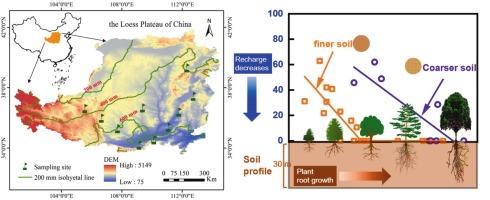生根深度支配着农林业系统中的地下水补给:旱地造林对水可持续性的影响
IF 6.3
1区 地球科学
Q1 ENGINEERING, CIVIL
引用次数: 0
摘要
在旱地农林复合系统中,为了生态恢复而进行的大规模造林往往会损害地下水的可持续性,但树种特征(如生根深度)和土壤-植被相互作用的作用尚不清楚。对黄土高原32个配对样地的14种深根造林树种(13种乔木、1种灌木)与相邻的浅根作物(玉米、小麦、小米等)进行了对比研究。通过土壤水分剖面、根系测绘和氚示踪,我们发现与浅根植被相比,深根植被(4.8-28 m)减少了0-2131 mm的土壤储水量和至少67.2%的地下水补给。根系深度解释了72%的补给变化,优于气候和土壤因子。此外,根系深度对补给的不利影响受到土壤质地的强烈调节,质地较粗的土壤通过增强深层渗透来减弱这种影响。这些研究结果为旱地农林复合系统选择需水量低的树种(如浅根红枣)维持地下水补给提供了科学依据。我们的研究结果量化了造林目标和地下水安全之间的权衡,为气候智能型土地利用规划提供了可行的见解。本文章由计算机程序翻译,如有差异,请以英文原文为准。

Rooting depth governs groundwater recharge in agroforestry systems: Implications for water sustainability under dryland afforestation
In dryland agroforestry systems, large-scale afforestation for ecological restoration often compromises groundwater sustainability, yet the roles of tree species traits (e.g., rooting depth) and soil-vegetation interactions remains unclear. We conducted a field study on the Loess Plateau, comparing 14 deep-rooted afforestation species (13 trees, 1 shrub) with adjacent shallow-rooted crops (maize, wheat, millet, etc.) across 32 paired sites. Using soil water profiling, root mapping, and tritium tracing, we found that deep rooting (4.8–28 m) reduced soil water storage by 0–2131 mm and groundwater recharge by at least 67.2 % compared to shallow-rooted vegetation. Rooting depth explained 72 % of recharge variation, outperforming climate and soil factors. Moreover, the adverse effect of rooting depth on recharge was strongly modulated by soil texture, as coarser-textured soils weaken this impact by enhancing deep percolation. These findings provide a scientific basis for selecting low-water-demand tree species (e.g., shallow-rooted Ziziphus jujuba) to maintain groundwater recharge in dryland agroforestry systems. Our results quantify the trade-off between afforestation goals and groundwater security, offering actionable insights for climate-smart land-use planning.
求助全文
通过发布文献求助,成功后即可免费获取论文全文。
去求助
来源期刊

Journal of Hydrology
地学-地球科学综合
CiteScore
11.00
自引率
12.50%
发文量
1309
审稿时长
7.5 months
期刊介绍:
The Journal of Hydrology publishes original research papers and comprehensive reviews in all the subfields of the hydrological sciences including water based management and policy issues that impact on economics and society. These comprise, but are not limited to the physical, chemical, biogeochemical, stochastic and systems aspects of surface and groundwater hydrology, hydrometeorology and hydrogeology. Relevant topics incorporating the insights and methodologies of disciplines such as climatology, water resource systems, hydraulics, agrohydrology, geomorphology, soil science, instrumentation and remote sensing, civil and environmental engineering are included. Social science perspectives on hydrological problems such as resource and ecological economics, environmental sociology, psychology and behavioural science, management and policy analysis are also invited. Multi-and interdisciplinary analyses of hydrological problems are within scope. The science published in the Journal of Hydrology is relevant to catchment scales rather than exclusively to a local scale or site.
 求助内容:
求助内容: 应助结果提醒方式:
应助结果提醒方式:


